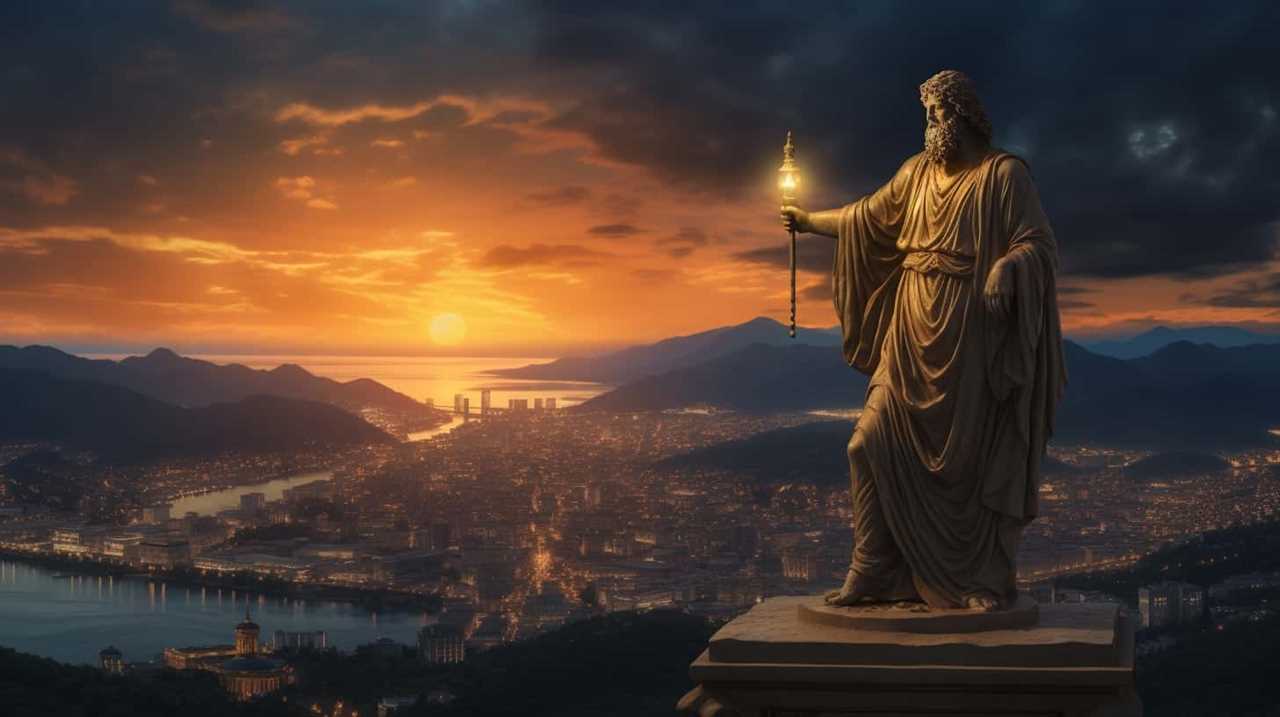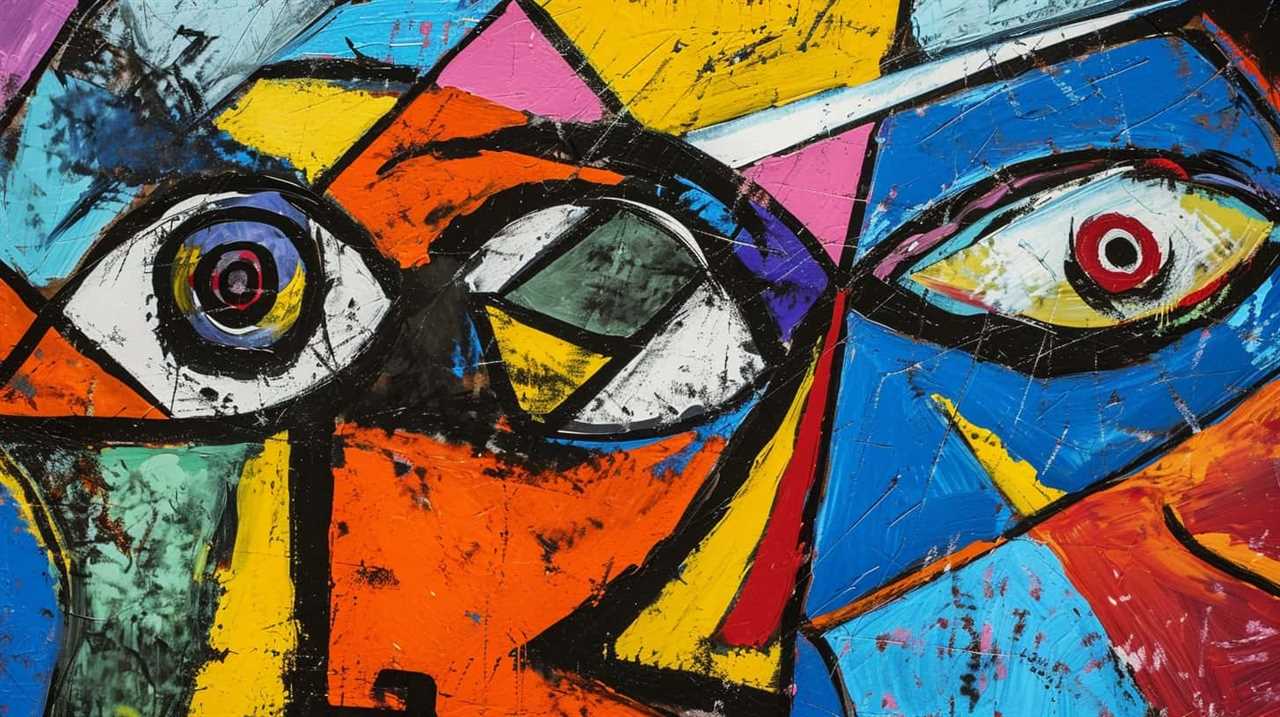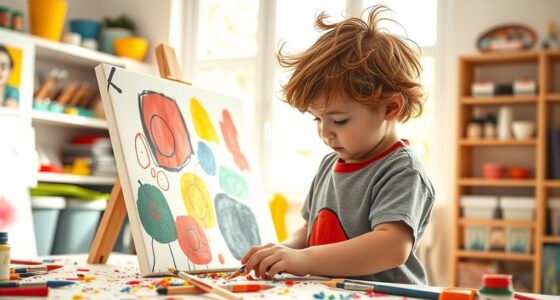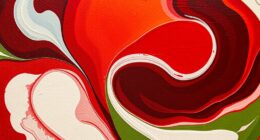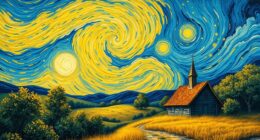What do great artists say about art’s purpose?
Delving into the minds of these masterful creators provides us with profound insights into the essence and significance of art. Throughout history, artists such as Pablo Picasso, Vincent Van Gogh, Frida Kahlo, Salvador Dali, Georgia O’Keeffe, Jackson Pollock, Michelangelo, Wassily Kandinsky, and Andy Warhol have expressed their thoughts on the purpose of art.
Their perspectives span a wide spectrum, reflecting the diversity and complexity of artistic expression. From Picasso’s exploration of form and color to Van Gogh’s passionate portrayal of emotion, each artist offers a unique lens through which we can contemplate the purpose and power of art.
Join us as we delve into the wisdom and inspiration provided by these great artists, uncovering the profound impact of art on our lives.

Key Takeaways
- Great artists such as Picasso, Van Gogh, Kahlo, and Dali used their artwork as a means of self-expression and to convey intense emotions or experiences.
- Art has the power to inspire and influence viewers, evoking raw emotions and connecting with them on a profound level.
- Art can challenge societal norms, shape society, and serve as a vehicle for personal and collective healing.
- Some artists believe that art goes beyond the physical world and has a spiritual essence, awakening the viewer’s inner self and triggering transformative experiences.
Pablo Picasso’s Perspective
Pablo Picasso believed that art brings forth a unique and transformative perspective on the world. His influence in the art world is undeniable, as he revolutionized artistic techniques and challenged traditional norms. Picasso’s ability to break away from conventional forms and explore new possibilities allowed him to create works that were both innovative and thought-provoking.
One of Picasso’s most significant contributions was his development of Cubism. This artistic movement emphasized the use of geometric shapes and multiple viewpoints to depict subjects. By deconstructing objects and rearranging their forms, Picasso challenged the notion of representing reality as it appears to the eye. His innovative approach to composition and perspective had a profound impact on the art world, inspiring countless artists to explore new ways of seeing and representing the world around them.
Picasso’s influence extended beyond his artistic techniques. He was also known for his ability to capture the essence of his subjects, whether it be through his portraits or his depictions of everyday life. His works often conveyed a sense of emotion and depth, inviting viewers to engage with the artwork on a personal level. Picasso’s ability to evoke emotion through his art was a testament to his mastery and his understanding of the power of visual expression.
Vincent Van Gogh’s Artistic Vision
When examining Vincent Van Gogh’s artistic vision, we’re struck by his ability to convey intense emotional expression through his paintings.
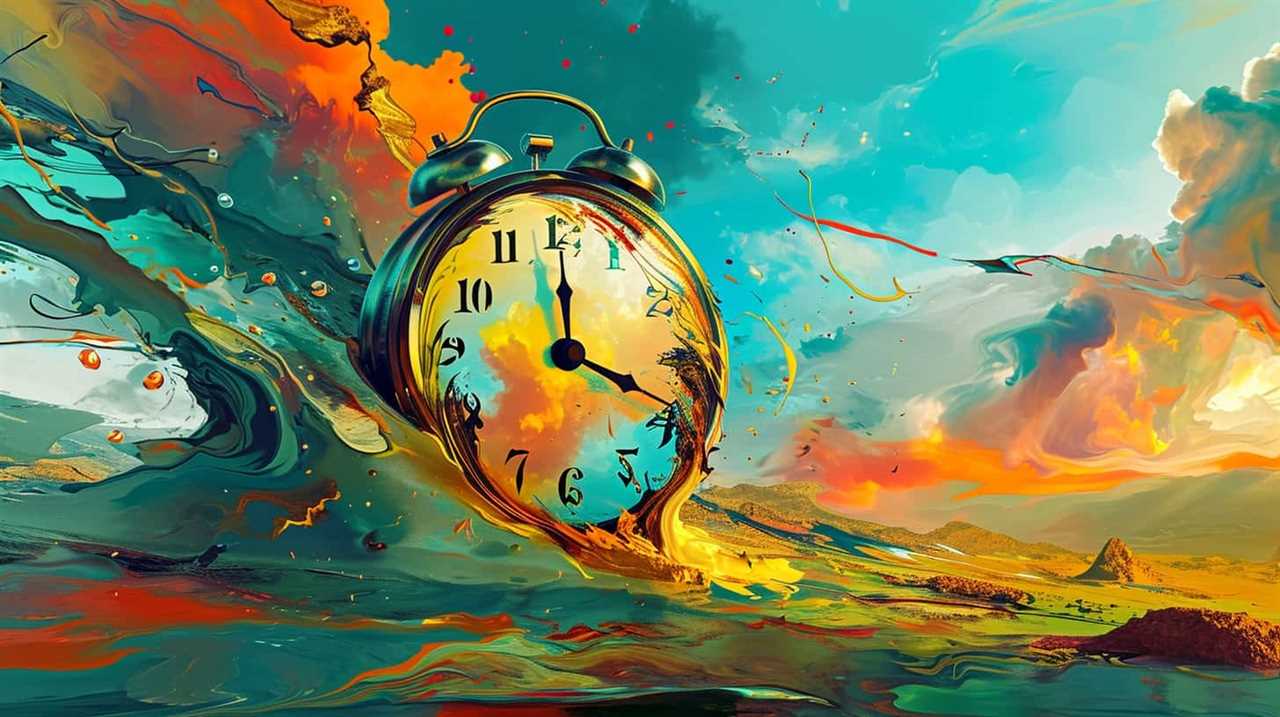
His use of bold brushstrokes and vibrant colors evokes a sense of raw emotion and captures the essence of his subjects.
Van Gogh’s Emotional Expression
Our understanding of Vincent Van Gogh’s artistic vision is deepened when we consider his emotional expression in his paintings. Van Gogh’s mental health greatly influenced his art, as he used painting as a way to cope with his inner turmoil. His brushwork technique, characterized by bold, vibrant strokes, reflected the intensity of his emotions and allowed him to convey his thoughts and feelings on canvas. Through his artwork, Van Gogh sought to capture the essence of the human experience, expressing his own pain, joy, and longing. His use of color, texture, and composition evoked a sense of raw emotion, inviting viewers to connect with his work on a profound level. Van Gogh’s emotional expression continues to resonate with audiences today, reminding us of the power of art to convey the depths of the human soul.
| Emotional Expression | Brushwork Technique |
|---|---|
| Bold, vibrant strokes | Intensity of emotions |
| Conveying thoughts and feelings | Raw emotion |
| Inviting connection | Power of art |
Impact of Color Choices
Continuing from our exploration of Van Gogh’s emotional expression, let’s now delve into the impact of his color choices on his artistic vision.
Van Gogh was known for his bold and vibrant use of color, which had profound psychological effects on the viewer. By using intense hues and contrasting tones, he aimed to evoke strong emotions and convey his inner turmoil.

The psychological effects of his color choices weren’t only evident in his self-portraits but also in his landscapes and still life paintings.
Moreover, Van Gogh’s color choices had cultural significance as well. His use of vivid shades reflected his belief in the power of color to communicate universal emotions and transcend cultural boundaries.
Through his art, Van Gogh sought to create a visual language that resonated with people from all walks of life, making his work timeless and universally relatable.
Frida Kahlo on Self-Expression
In discussing Frida Kahlo’s perspective on self-expression, we can glean valuable insights from her powerful and deeply personal artworks. Frida Kahlo is renowned for her self-portraits, which provide a window into her inner thoughts, emotions, and experiences. Through her art, Kahlo explores themes of identity, pain, and resilience, offering a unique and unfiltered perspective on the human condition.

One of the key influences on Frida Kahlo’s self-expression was her Mexican heritage and culture. Kahlo celebrated her indigenous roots and incorporated elements of Mexican folklore and symbolism in her artwork. She often dressed in traditional Mexican clothing, embracing her identity and challenging societal norms. By doing so, she sought to reclaim her cultural heritage and challenge the dominant Eurocentric ideals of beauty and femininity.
Kahlo’s self-portraits serve as a means of self-exploration and self-assertion. She used her artwork as a cathartic outlet to express her physical and emotional pain, stemming from her lifelong struggles with illness and personal tragedies. Through her paintings, Kahlo communicates her innermost thoughts and feelings, allowing viewers to connect with her on a deeply emotional level.
Frida Kahlo’s self-expression transcends mere aesthetics; it serves as a vehicle for personal and collective healing. Her art confronts societal taboos, challenges conventional notions of beauty, and advocates for self-acceptance and self-empowerment. Kahlo’s ability to capture the complexity of the human experience through her self-portraits continues to resonate with audiences worldwide, emphasizing the transformative power of art in expressing one’s truth and forging connections across cultures and generations.
Salvador Dali’s Surreal Insights
For our exploration of Salvador Dali’s surreal insights, we’ll delve into the extraordinary world of his artistic vision. Dali, a master of dreamlike symbolism, believed in the power of the subconscious to unlock hidden truths and create profound art. His works, such as ‘The Persistence of Memory’ and ‘The Elephants,’ are renowned for their enigmatic and thought-provoking imagery.
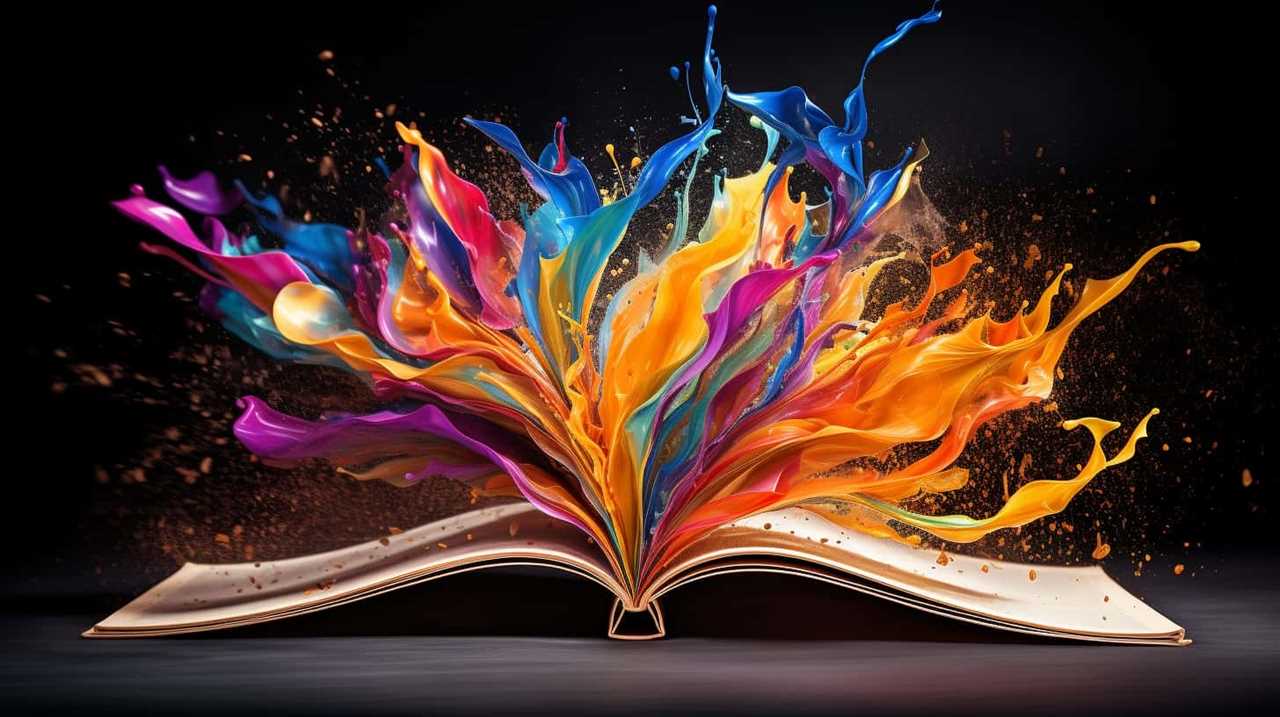
Dali’s dreamlike symbolism is evident in his use of melting clocks, floating objects, and distorted figures. These elements, often juxtaposed in uncanny and unexpected ways, invite viewers to question their own perceptions and embrace the irrationality of the subconscious mind. Through his unique artistic language, Dali aimed to challenge the boundaries of reality and tap into the depths of human imagination.
In his exploration of the subconscious, Dali sought to reveal the hidden desires, fears, and contradictions that lie beneath the surface of our conscious minds. He believed that by accessing these buried emotions, he could create art that resonated on a profound and universal level. Dali’s surreal insights offer us a window into the mysterious workings of the human psyche, reminding us of the vast complexity that exists within each of us.
Georgia O’Keeffe’s Unique Perspective
Georgia O’Keeffe’s artistic perspective offers a fresh and captivating exploration of the natural world. She was known for her unique approach to painting, which combined abstract and representational elements to create stunning works of art. O’Keeffe’s use of color symbolism played a crucial role in conveying the essence of her subjects. Through her bold and vibrant color choices, she was able to evoke emotions and capture the energy and vitality of nature.
Here are some key aspects of Georgia O’Keeffe’s unique perspective:

- Intimate Connection with Nature: O’Keeffe had a deep appreciation for the natural world and found inspiration in its beauty. Her paintings often depicted close-up views of flowers, landscapes, and other natural forms, inviting viewers to experience the intricate details and textures of these subjects.
- Simplified Forms: O’Keeffe had a knack for distilling complex subjects into simplified forms. She believed in the power of simplicity and used it to convey the essence of her subjects. By reducing details and focusing on the essential elements, she created a sense of harmony and balance in her compositions.
- Emphasis on Abstraction: While O’Keeffe’s paintings were inspired by nature, she didn’t merely replicate what she saw. Instead, she infused her work with elements of abstraction, allowing her to express her unique vision and interpretation of the natural world. Her abstract approach added depth and complexity to her paintings, making them more than just mere representations.
- Celebration of Female Identity: O’Keeffe’s art also explored themes of female identity and empowerment. Through her depictions of flowers and other feminine symbols, she challenged traditional gender roles and presented a more nuanced and empowering vision of women.
Georgia O’Keeffe’s unique perspective, characterized by her use of color symbolism and nature-inspired art, continues to inspire artists and captivate audiences to this day. Her ability to convey the beauty and energy of the natural world through her paintings remains a testament to her mastery as an artist.
Leonardo Da Vinci’s Artistic Purpose
When considering Leonardo Da Vinci’s artistic purpose, we must first acknowledge his multifaceted intentions.
Da Vinci believed that art had the power to shape society, and as such, he sought to create works that weren’t only visually captivating but also intellectually stimulating.
His genius lay in his ability to merge science and art, infusing his paintings with a depth of knowledge that challenged traditional notions of what art could achieve.
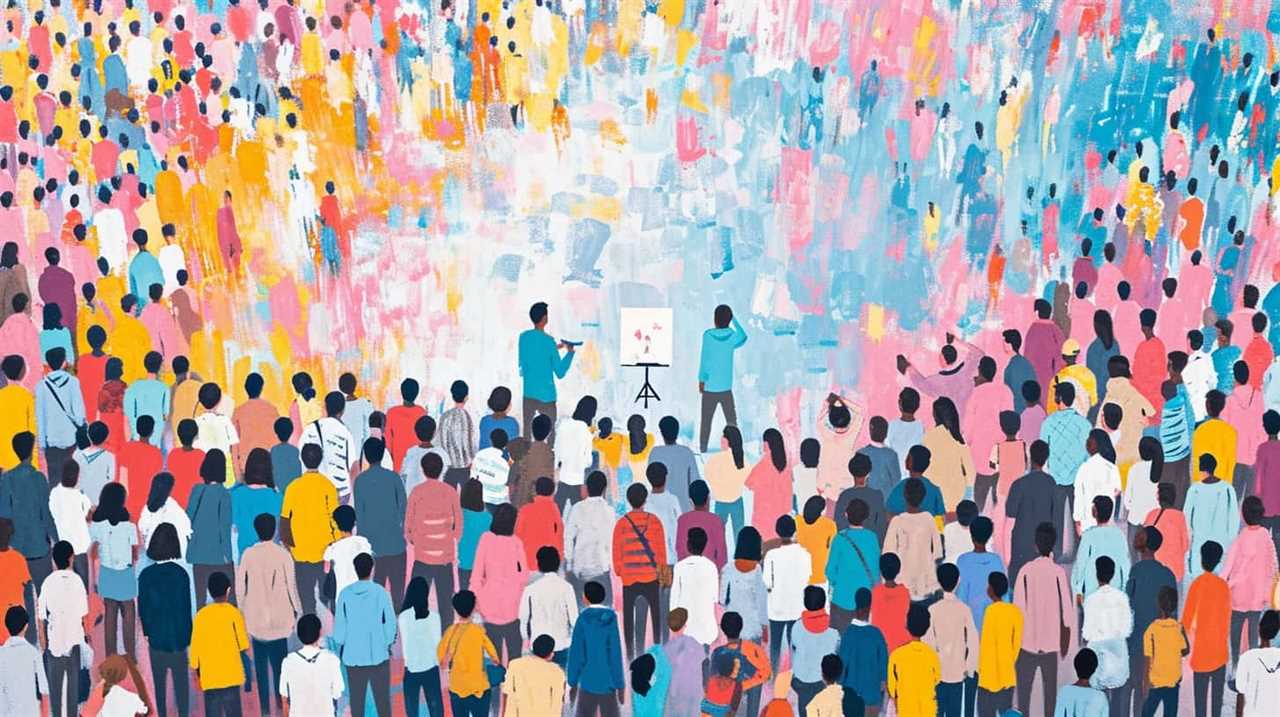
Da Vinci’s art was a reflection of his insatiable curiosity, pushing the boundaries of what was possible and leaving a lasting impact on the world of art.
Da Vinci’s Artistic Intent
Our exploration of Da Vinci’s artistic intent reveals the profound depth of his creativity and the transformative power of his vision.
Da Vinci’s artistic techniques were marked by his meticulous attention to detail and his mastery of various mediums, such as oil paint and chalk. His ability to capture the human form with such precision and realism is a testament to his skill as an artist.
Additionally, Da Vinci understood the importance of composition in creating a visually compelling and harmonious artwork. He’d carefully arrange the elements within his paintings to create a sense of balance and unity. This attention to composition allowed him to convey meaning and emotion in his works.

Da Vinci’s commitment to excellence and his unwavering pursuit of artistic perfection continue to inspire artists and art enthusiasts alike.
Art’s Societal Impact
How does Leonardo Da Vinci’s artistic purpose impact society?
Leonardo Da Vinci, a true genius of the Renaissance, believed that art had a profound societal impact. His artworks, such as the iconic Mona Lisa and The Last Supper, continue to captivate audiences and leave a lasting impression.
Da Vinci saw art as a form of communication that transcended language barriers and spoke directly to the human spirit. Through his intricate brushstrokes and attention to detail, he aimed to evoke emotions and provoke thought.

Moreover, Da Vinci recognized the therapeutic benefits of art, believing that it could heal and inspire individuals. His belief in the power of art to affect society is still relevant today, as art continues to shape our understanding of the world and provide solace in times of distress.
Claude Monet’s Impressionistic Approach
We frequently admire Claude Monet’s impressionistic approach to art. His revolutionary style, characterized by loose brushstrokes and vibrant colors, had a profound impact on the art world and continues to influence future artists.
Here are some key aspects of Monet’s impressionistic approach:
- Impact of brushstrokes: Monet’s brushstrokes were bold and visible, capturing the essence of his subjects with remarkable energy and spontaneity. He abandoned the traditional smooth and blended brushwork, opting instead for quick, broken strokes that conveyed movement and atmosphere. This technique allowed him to capture the fleeting effects of light and the ever-changing nature of his surroundings.
- Capturing the essence of a moment: Monet’s impressionistic approach aimed to capture the fleeting qualities of nature and everyday life. He sought to depict the ever-changing atmosphere, emphasizing the play of light and color. By focusing on the momentary impressions rather than precise details, his paintings evoke a sense of immediacy and evoke an emotional response from the viewer.
- Emphasis on color and light: Monet’s use of vibrant colors and the juxtaposition of complementary hues created a sense of luminosity and depth in his paintings. He observed the effects of natural light on his subjects and skillfully translated them onto the canvas, giving his works a sense of vitality and vibrancy.
- Influence on future artists: Monet’s impressionistic approach paved the way for countless artists who sought to challenge traditional artistic conventions. His emphasis on capturing the essence of a moment and the expressive use of brushstrokes inspired future movements such as Post-Impressionism, Fauvism, and even Abstract Expressionism.
Jackson Pollock’s Abstract Expression
When exploring Jackson Pollock’s abstract expression, it’s crucial to consider his artistic influences, such as Native American art and Surrealism, which greatly shaped his unique style.

The impact of abstract expressionism on the art world can’t be underestimated, as Pollock’s bold and spontaneous approach challenged traditional notions of representation and paved the way for future generations of artists to explore the limits of artistic expression.
However, Pollock’s work wasn’t without controversy, with some critics questioning the validity and meaning behind his seemingly chaotic and nonrepresentational compositions.
Pollock’s Artistic Influences
In the realm of abstract expressionism, the artistic influences that shaped Jackson Pollock’s unique style are worth exploring. Pollock drew inspiration from a variety of sources, which contributed to his groundbreaking approach to art. These influences can be summarized as follows:
- Nature: Pollock was deeply influenced by the natural world, particularly the rhythmic patterns and organic forms found in nature. This influence is evident in his use of flowing lines and energetic brushstrokes, which mimic the movement of natural elements.
- Experimentation with materials: Pollock revolutionized the art world by experimenting with unconventional materials. He explored the possibilities of pouring, dripping, and splattering paint onto his canvases, pushing the boundaries of traditional painting techniques.
- Other artists: Pollock was influenced by the works of Mexican muralists like David Alfaro Siqueiros, who emphasized the importance of social and political themes in their art. He also looked to the works of European modernists, such as Pablo Picasso and Joan Miró, for inspiration.
By incorporating these influences into his artistic practice, Pollock created a unique style that would have a profound impact on the world of abstract expressionism.
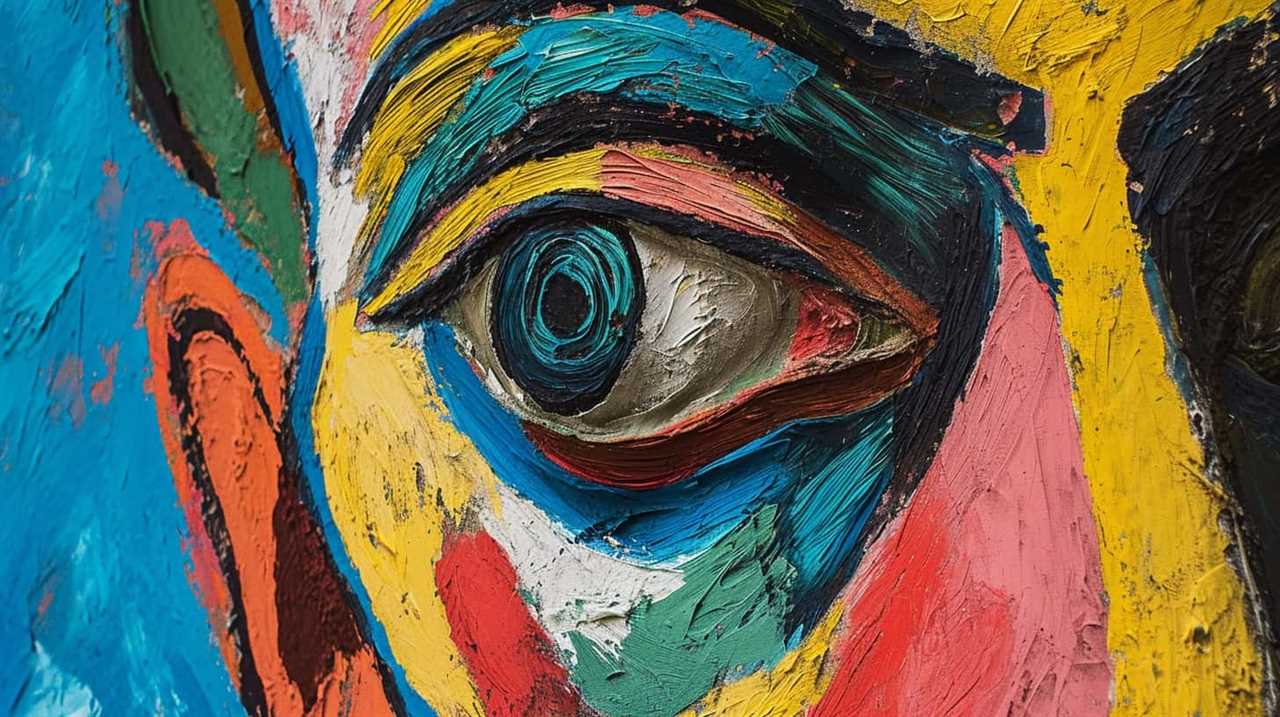
Now, let’s delve into the impact of abstract expressionism on the art world.
Impact of Abstract Expression
Abstract Expressionism, specifically Jackson Pollock’s Abstract Expression, had a profound impact on the art world. This movement revolutionized the way artists approached their work, emphasizing the importance of emotional connection and artistic freedom.
Pollock’s unique style, characterized by his signature drip painting technique, challenged traditional notions of representation and encouraged viewers to engage with art on a deeper, more personal level. His paintings, with their dynamic and spontaneous brushwork, allowed viewers to interpret and connect with the artwork in their own way, evoking a range of emotions and experiences.
The freedom and expressiveness of Abstract Expressionism opened up new possibilities for artists, inspiring them to explore their inner selves and push the boundaries of artistic expression. Pollock’s Abstract Expression became a catalyst for change, influencing subsequent generations of artists and forever altering the course of art history.

Controversy Surrounding Pollock
The controversy surrounding Pollock’s Abstract Expression stems from differing opinions on its artistic merit and its departure from traditional techniques. Some view Pollock’s controversial techniques as a revolutionary artistic breakthrough, while others criticize his work as lacking skill and technique.
The key points of contention include:
- Rejection of conventional composition: Pollock’s abandonment of traditional methods of painting, such as using brushes and easels, sparked debates about the validity of his approach.
- Emphasis on process: Pollock’s focus on the physical act of painting, including his famous technique of dripping and pouring paint onto the canvas, challenged the notion of a finished artwork.
- Interpretation of meaning: The abstract nature of Pollock’s work led to debates about its purpose and whether it held any deeper significance beyond its surface appearance.
- Impact on the art world: Pollock’s work challenged established norms and paved the way for new artistic movements, causing both excitement and resistance within the art community.
The controversy surrounding Pollock’s Abstract Expression continues to provoke discussions about the boundaries of art and the role of technique in determining artistic value.
Michelangelo’s Artistic Mastery
Our exploration of Michelangelo’s artistic mastery reveals the profound impact he’d on the art world. Michelangelo’s sculptural genius and innovative artistic techniques have made him one of the most influential artists of all time. His ability to bring life to stone through his sculptures is unparalleled. The way he captured the human form with such precision and detail is a testament to his mastery.
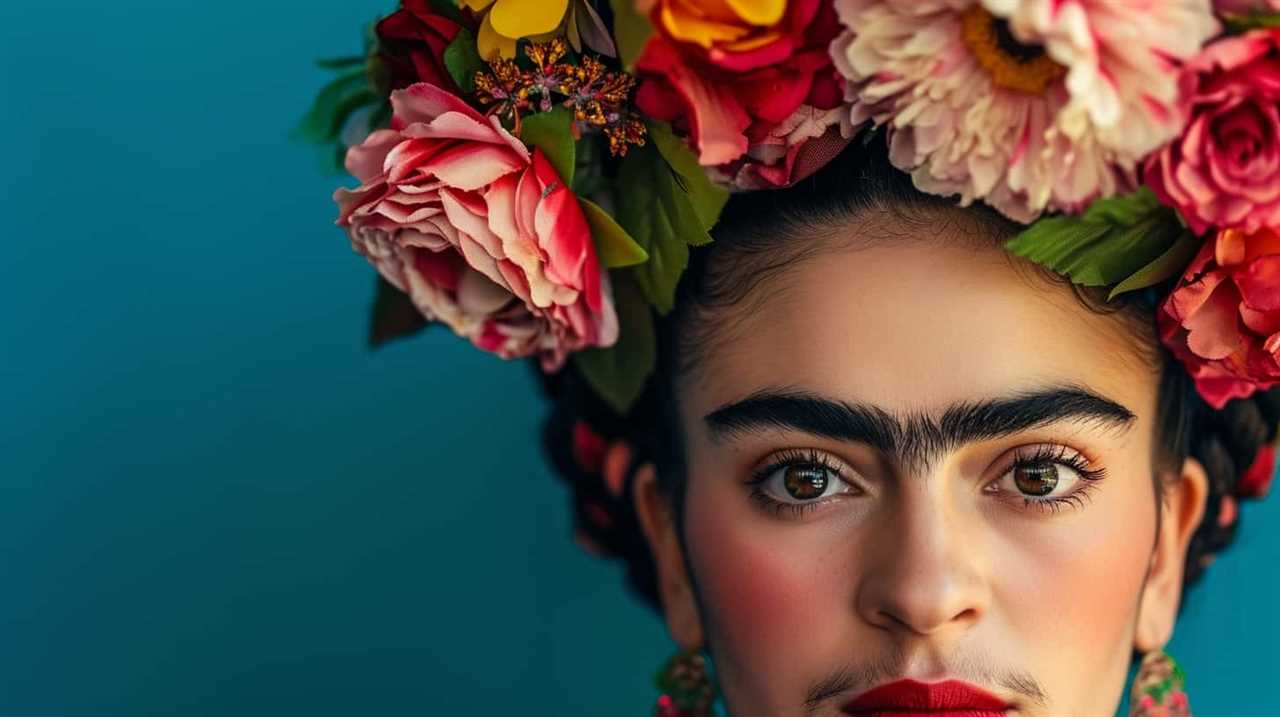
Michelangelo’s artistic techniques were groundbreaking for his time. He was able to create a sense of movement and emotion in his sculptures, making them come alive. One of his most famous works, the David, is a prime example of his skill. The way he depicted the muscularity and tension in the figure’s body is awe-inspiring. It’s as if the sculpture is about to spring to life.
His mastery extended beyond sculpture to other mediums as well. Michelangelo was a skilled painter, architect, and poet. His frescoes in the Sistine Chapel are some of the most celebrated works in art history. The level of detail and complexity in these paintings is astonishing. Each figure tells a story and contributes to the overall narrative of the chapel.
In conclusion, Michelangelo’s artistic mastery revolutionized the art world. His ability to breathe life into his sculptures and his innovative techniques continue to inspire artists today. His impact on the art world is undeniable and his legacy will forever be remembered.
Transitioning to the next section, let’s now delve into Wassily Kandinsky’s perspective on spiritual art.
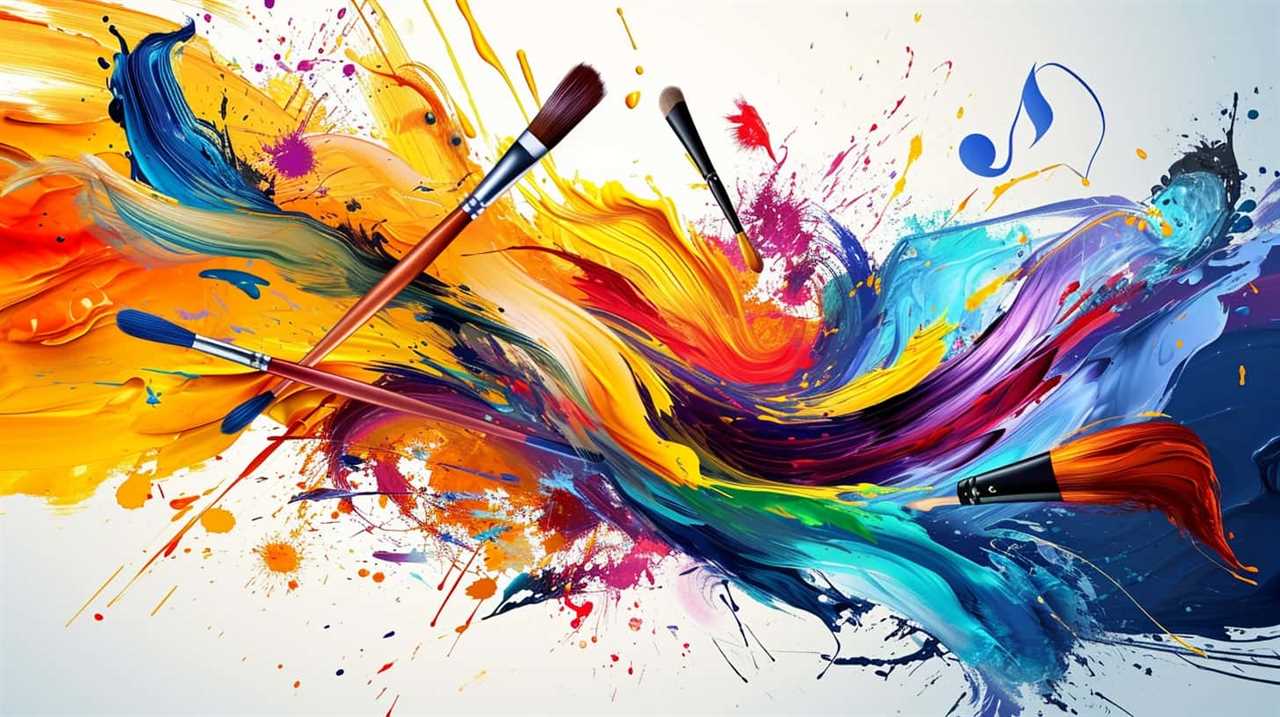
Wassily Kandinsky on Spiritual Art
Kandinsky’s perspective on spiritual art offers a unique insight into the transformative power of creativity. He believed that art had the ability to connect with the spiritual realm and evoke profound emotions in the viewer.
Here are some key ideas that highlight Kandinsky’s take on spirituality in art and the role of emotions in it:
- Art as a spiritual expression: Kandinsky saw art as a means to access and communicate spiritual truths that are beyond the realm of the physical world.
- Emotions as a gateway: He believed that emotions played a crucial role in art, acting as a bridge between the artist and the viewer, allowing them to connect on a deeper level.
- The power of abstraction: Kandinsky championed abstract art as a way to express the spiritual and emotional essence of the subject matter, free from the constraints of representation.
- Art as a catalyst for transformation: According to Kandinsky, experiencing spiritual art had the potential to awaken the viewer’s inner self, leading to personal growth and enlightenment.
Kandinsky’s ideas challenge traditional notions of art and invite us to explore the spiritual dimensions of creativity. His emphasis on emotions and abstraction paved the way for a new understanding of art’s purpose.
With this in mind, let’s turn our attention to Andy Warhol’s reflections on pop art.

Andy Warhol’s Pop Art Reflections
Now let’s delve into Andy Warhol’s reflections on pop art and its purpose.
Andy Warhol, a prominent figure in the pop art movement of the 1960s, used his artwork to explore the impact of consumer culture and critique mass production. Through his iconic pieces such as Campbell’s Soup Cans and Marilyn Monroe portraits, Warhol sought to challenge traditional notions of high art and elevate everyday objects and images to the realm of artistic expression.
By depicting popular consumer products and celebrities, Warhol highlighted the pervasive influence of consumer culture on society. He recognized that mass production and the commodification of goods had become an integral part of modern life, and he sought to reflect this reality in his artwork. Warhol’s use of vibrant colors and repeated imagery further emphasized the ubiquity of consumer culture, inviting viewers to question their own relationship with the objects that surround them.
Furthermore, Warhol’s art served as a critique of mass production. By reproducing images through screen printing techniques, he stripped away the uniqueness and individuality traditionally associated with fine art. Instead, he embraced the reproducibility and accessibility of mass-produced goods, challenging the notion of art as a rarefied and exclusive domain.
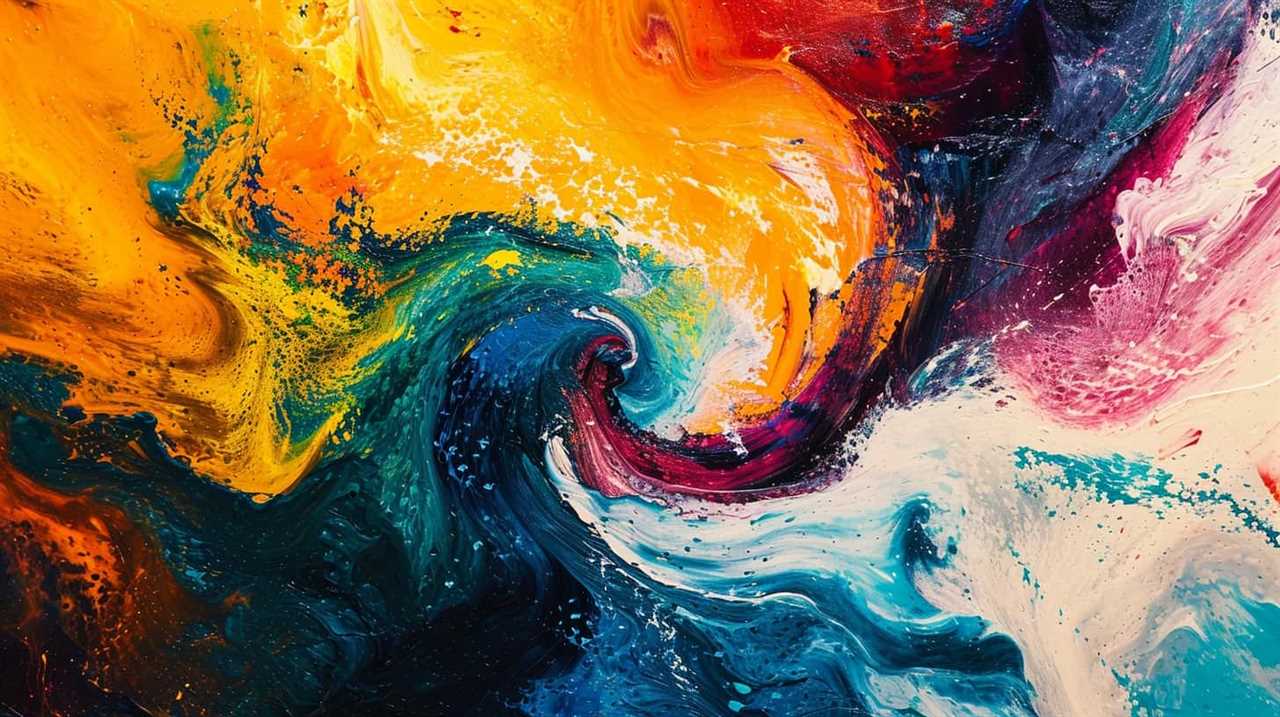
Frequently Asked Questions
What Were Some of Picasso’s Most Famous Artworks?
Picasso’s Blue Period and Guernica are two of his most famous artworks. In the Blue Period, he depicted somber and melancholic subjects, while Guernica is a powerful anti-war mural that conveys the horrors of conflict.
How Did Van Gogh’s Mental Health Affect His Artwork?
Van Gogh’s mental health had a profound impact on his artwork. His struggles influenced his artistic style, leading to the creation of emotionally charged and expressive masterpieces that continue to captivate audiences to this day.
What Were the Major Themes in Frida Kahlo’s Paintings?
In Frida Kahlo’s paintings, she explores major themes such as identity and self-expression, as well as pain and suffering. Her art delves into the depths of human experience, revealing profound emotions and personal struggles.
How Did Salvador Dali’s Surrealism Influence Other Artists?
Salvador Dali’s surrealism influenced other artists by pushing the boundaries of artistic expression. His unique style and exploration of the subconscious had a profound impact on the art world, inspiring new ways of seeing and creating.

Can You Provide Examples of Georgia O’keeffe’s Unique Perspective in Her Artwork?
Different interpretations of Georgia O’Keeffe’s artwork reveal her unique perspective. Through her use of vibrant colors, magnified flowers, and desert landscapes, O’Keeffe’s art conveys a sense of feminine empowerment and celebrates the beauty of nature.
Conclusion
In conclusion, the great artists of history have shared profound insights into the purpose of art. From Picasso’s belief in the power of creativity to Van Gogh’s vision of capturing the essence of life, each artist brings a unique perspective.
Kahlo’s self-expression, Dali’s surrealism, and O’Keeffe’s unique perspective on nature all contribute to the rich tapestry of artistic expression. Pollock’s abstract expressionism, Michelangelo’s artistic mastery, Kandinsky’s spiritual art, and Warhol’s pop art reflections further demonstrate the diverse and transformative power of art.
Through their words and works, these artists remind us of the immense impact that art can have on our lives.
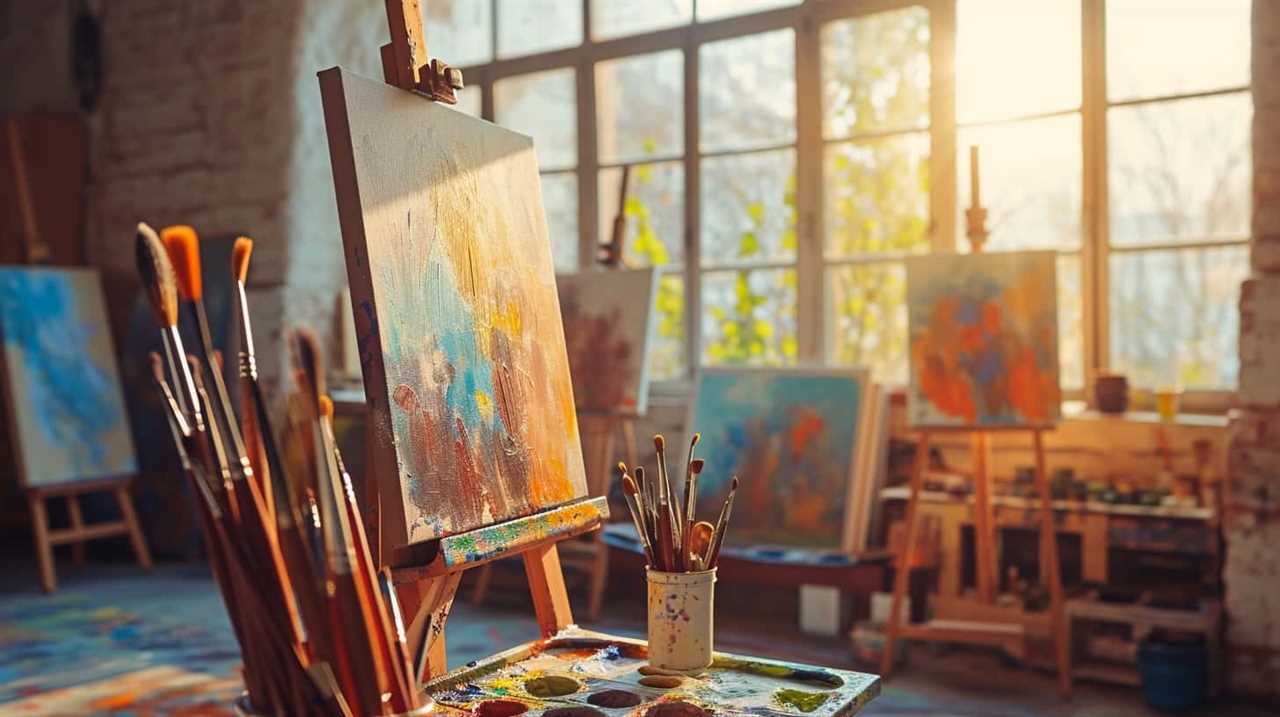
Lauren’s talent in writing is matched by her passion for storytelling. Her love for books and deep understanding of culture and entertainment add a distinct flavor to her work. As our media and press contact, Lauren skillfully bridges the gap between afterQuotes and the broader media landscape, bringing our message to a wider audience.

